 W
WAncient Chinese coinage includes some of the earliest known coins. These coins, used as early as the Spring and Autumn period (770–476 BCE), took the form of imitations of the cowrie shells that were used in ceremonial exchanges. The Spring and Autumn period also saw the introduction of the first metal coins; however, they were not initially round, instead being either knife shaped or spade shaped. Round metal coins with a round, and then later square hole in the center were first introduced around 350 BCE. The beginning of the Qin Dynasty (221–206 BCE), the first dynasty to unify China, saw the introduction of a standardised coinage for the whole Empire. Subsequent dynasties produced variations on these round coins throughout the imperial period. At first the distribution of the coinage was limited to use around the capital city district, but by the beginning of the Han Dynasty, coins were widely used for such things as paying taxes, salaries and fines.
 W
WBingqian, or Bingxingqian, is a term, which translates into English as "biscuit coins", "pie coins", or "cake coins", used by Chinese and Taiwanese coin collectors to refer to cash coins with an extremely broad rim as, these cash coins can also be very thick. While the earliest versions of the Bingqian did not extraordinarily broad rims.
 W
WCash was a type of coin of China and East Asia, used from the 4th century BC until the 20th century AD, characterised by their round outer shape and a square center hole. Originally cast during the Warring States period, these coins continued to be used for the entirety of Imperial China as well as under Mongol and Manchu rule. The last Chinese cash coins were cast in the first year of the Republic of China. Generally most cash coins were made from copper or bronze alloys, with iron, lead, and zinc coins occasionally used less often throughout Chinese history. Rare silver and gold cash coins were also produced. During most of their production, cash coins were cast, but during the late Qing dynasty, machine-struck cash coins began to be made. As the cash coins produced over Chinese history were similar, thousand year old cash coins produced during the Northern Song dynasty continued to circulate as valid currency well into the early twentieth century.
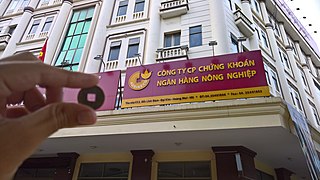 W
WCash coins are a type of historical Chinese, Japanese, Korean, Ryukyuan, and Vietnamese coin design that was the main basic design for the Chinese cash, Japanese mon, Korean mun, Ryukyuan mon, and Vietnamese văn currencies. The cash coin became the main standard currency of China in 221 BC with the Ban Liang (半兩) and would produced until 1912 AD there with the Minguo Tongbao (民國通寶), the last series of cash coins produced in the world were the French Indochinese Bảo Đại Thông Bảo (保大通寶) during the 1940s. Cash coins are round coins with a square centre hole. It is commonly believed that the early round coins of the Warring States period resembled the ancient jade circles (璧環) which symbolised the supposed round shape of the sky, while the centre hole in this analogy is said to represent the planet earth (天圓地方). The body of these early round coins was called their "flesh" (肉) and the central hole was known as "the good" (好).
 W
WThe cash was a currency denomination used in China in imperial times. It was the chief denomination until the introduction of the yuan in the late 19th century.
 W
WDaqian are large denomination cash coins that were produced in the Qing dynasty starting from 1853 until 1890. Large denomination cash coins were previously used in earlier Chinese dynasties and had faced similar issues as the 19th century Daqian. The term referred to cash coins with a denomination of 4 wén or higher.
 W
WThe kingdom of Goryeo used various currencies during its almost five centuries of rule on the Korean Peninsula. Both commodity and metallic money were used, often concurrently, in a "hybrid currency system": The metallic money consisted of coins, both Chinese and Korean, and silver currencies. Paper money was used during the late Goryeo period.
 W
W"Red cash coins" are the cash coins produced in Xinjiang under Qing rule following the conquest of the Dzungar Khanate by the Manchus in 1757. While in Northern Xinjiang the monetary system of China proper, with standard cash coins, was adopted in Southern Xinjiang where the pūl (ﭘول) coins of Dzungaria circulated earlier the pūl-system was continued but some of the old Dzungar pūl coins were melted down to make Qianlong Tongbao (乾隆通寶) cash coins, as pūl coins were usually around 98% copper they tended to be very red in colour which gave the cash coins based on the pūl coins the nickname "red cash coins".
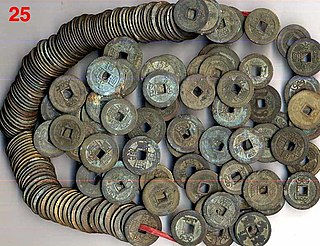 W
WCash coins were introduced by the Chinese based on their imperial coinage to what is today called Indonesia during the Tang dynasty era in China when they were introduced by traders, but they didn't become popular with the local population until the 13th century during the reign the Majapahit empire in the archipelago. Chinese cash coins continued to circulate in the archipelago for centuries, when the Ming dynasty banned trade with the region many local rulers started creating their own imitations of Chinese cash coins which were often thinner and of inferior quality. Cash coins produced in Indonesia were made from various materials such as copper-alloys, lead, and most commonly tin.
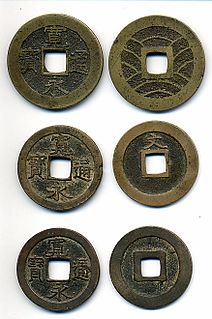 W
WThe mon (文) was the currency of Japan from the Muromachi period in 1336 until the early Meiji period in 1870. It co-circulated with the new sen until 1891. The Kanji for mon is 文 and the character for currency was widely used in the Chinese-character cultural sphere, e.g. Chinese wen, Korean mun. Throughout Japanese history, there were many different styles of currency of many shapes, styles, designs, sizes and materials, including gold, silver, bronze, etc. Coins denominated in mon were cast in copper or iron and circulated alongside silver and gold ingots denominated in shu, bu and ryō, with 4000 mon = 16 shu = 4 bu = 1 ryo. In 1869, due to depreciation against gold, the new fixing officially was set for 1 ryo/yen = equal to 10.000 mon. The yen started to replace the old duodecimal denominations in 1870: in 3rd quarter of 1870, the first new coins appeared, namely 5, 10, 50 sen silver and 2, 5, 10, 20 Yen. Smaller sen coins did not appear before spring, 1873. So the mon coins remained a necessity for ordinary peoples commodities and were allowed to circulate until 1891.12.31. Only from Jan. 1, 1954 onward the mon became invalid: postwar inflation had removed sen, mon etc. denominations smaller than 1 Yen. Due to the missing small coinage, the Japanese posts e.g. issued their first stamps in mon and fixed postal rates in mon until April, 1872.
 W
WThe Jin dynasty was a Jurchen-led dynasty of China that ruled over northern China and Manchuria from 1115 until 1234. After the Jurchens defeated the Liao dynasty and the Northern Song dynasty, they would continue to use their coins for day to day usage in the conquered territories. In 1234, they were conquered by the Mongol Empire.
 W
WThe mun was introduced as the main currency of Korea in 1625 and stayed in use until 1892. Prior to the mun, cash coins with the inscriptions tongbo (通寶) and jungbo (重寶) and silver vases called ŭnbyŏng were used as currency in the Goryeo Dynasty (918–1392), as well as imported Chinese currency. The mun resembled and was derived from the Chinese wén. Coins denominated in mun were cast in copper-alloys such as brass or bronze and were round with square holes. From the 17th century until the end of the 19th century, coins denominated in mun bearing the inscription Sangpyeong Tongbo, introduced in 1633, were the most widely circulated currency. In 1888, coins were struck in small numbers denominated in mun and won. The mun was replaced in 1892 when the yang was introduced.
 W
WKucha coinage was produced in the Kingdom of Kucha, a Buddhist state located in present-day Kucha County, Xinjiang. There are five known types of Kucha cash coins based on the Chinese Wu Zhu's. These coins are usually characterized by their diminutive size and thin shape. They are generally believed to have been produced between the years 265 and 589.
 W
WThe Liao dynasty was a Khitan-led dynasty of China that ruled over parts of Northern China, Manchuria, the Mongolian Plateau, northern Korean Peninsula, and what is modern-day Russian Far East from 916 until 1125 when it was conquered by the Jin dynasty. Remnants of the Liao court fled westward and created the Western Liao dynasty which in turn was annexed by the Mongol Empire in 1218.
 W
WChinese coinage in the Ming dynasty saw the production of many types of coins. During the Ming dynasty of China, the national economy was developed and its techniques of producing coinage were advanced. One early period example is the Bronze 1 cash. Obverse: "HUNG-WU T'UNG-P'AO" (洪武通寶). Reverse: blank. Average 23.8 mm, 3.50 grams.
 W
WMother coins, alternatively known as seed coins or matrix coins, were coins used during the early stages of the casting process to produce Chinese, Japanese, Korean, Ryukyuan, and Vietnamese cash coins. As cash coins were produced using sand casting mother coins were first produced to form the basis for all subsequent cash coins to be released into circulation. Under the Han dynasty in China mints started producing cash coins using bronze master moulds to solve inconsistencies in circulating coins, this only worked partially and by the sixth century mother coins were introduced to solve these inconsistencies almost completely. The Japanese adopted the usage of mother coins in the 600s and they were used to manufacture cast Japanese coins until the Meiji period. The mother coin was initially prepared by engraving a pattern with the legend of the cash coin which had to be manufactured. In the manufacturing process mother coins were used to impress the design in moulds which were made from easily worked metals such as tin and these moulds were then placed in a rectangular frame made from pear wood filled with fine wet sand, possibly mixed with clay, and enhanced with either charcoal or coal dust to allow for the molten metal to smoothly flow through, this frame would act as a layer that separates the two parts of the coin moulds. The mother coin was recovered by the people who cast the coins and was placed on top of the second frame and the aforementioned process was repeated until fifteen layers of moulds had formed based on this single mother coin. After cooling down a "coin tree" (錢樹) or long metallic stick with the freshly minted cash coins attached in the shape of "branches" would be extracted from the mould and these coins could be broken off and if necessary had their square holes chiseled clean, after this the coins were placed on a long metal rod to simultaneously remove the rough edges for hundreds of coins and then these cash coins could be strung together and enter circulation.
 W
WNagasaki trade coins (長崎貿易銭), also known as Nagasaki export coins refer to Japanese mon coins specifically cast for export by the Tokugawa government between 1659 and 1685 during the Sakoku era. Though the inscriptions on the coins often match Chinese coins from the Song dynasty they’re often cast with different typefaces such as the fact that the Genpō Tsūhō (元豊通寳) produced at Nagasaki was in Clerical script while the Song dynasty’s versions were in Seal script and Running script. Due to the success of these coins they’re often still found in modern day Vietnam and Java, and were copied by contemporary Vietnamese mints as they had become the de facto standard coinage in Vietnam as native production had declined in the 17th century. As the export of gold and silver was banned by the Qing dynasty Japanese merchants were most likely to go to Hanoi and Hội An to gain access to Chinese products causing these coins to start circulating en masse on the Vietnamese market. A special “5 elements” series of Nagasaki trade coins were also cast for export to Taiwan.
 W
WThe Ryukyuan mon was the currency of the Ryukyu Kingdom from 1454 to 1879, when the kingdom was annexed by the Empire of Japan and the currency was replaced by the Japanese yen. The Chinese character for mon is 文, which was widely used in the Chinese-character cultural sphere, e.g. Chinese wén, Vietnamese văn, and Korean mun. The Ryukyuans produced their own coins until the 15th century, but became dependent on Chinese coins until the 19th century when they briefly minted their own coins again. From 1862 the minting was outsourced to Kagoshima City, Satsuma Domain and were based on the Japanese mon. All of the Kagoshima-minted coins bear the phrase "Ryūkyū Tsūhō" (琉球通寳) ; this phrase was written in Seal script on the half shu coin. Despite the annexation of the Ryukyu Kingdom in 1879, these coins continued to circulate within Okinawa Prefecture well into the 1880s as the Ryukyuans were initially unwilling to use Japanese yen coins.
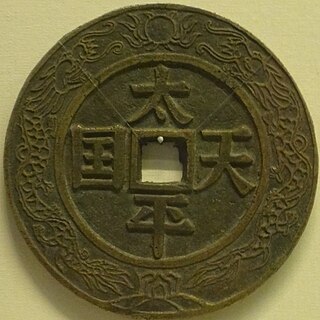 W
WThe currency of the Taiping Heavenly Kingdom consisted of Chinese cash coins and paper money, although the rarity of surviving Taiping paper money suggests that not much was produced. The first cash coins of the Taiping Heavenly Kingdom were issued in the year 1853 in the capital of Tianjing. The cash coins of the Taiping Heavenly Kingdom should not be confused with the Taiping Tongbao (太平通寳) which was issued during the Northern Song dynasty between the years 976 and 997, or with any other contemporary rebel coinage that also bear this inscription.
 W
WThe Southern Song dynasty refers to an era of the Song dynasty after Kaifeng was captured by the Jurchen Jin dynasty in 1127. The government of the Song was forced to establish a new capital city at Lin'an which wasn't near any sources of copper so the quality of the cash coins produced under the Southern Song significantly deteriorated compared to the cast copper-alloy cash coins of the Northern Song dynasty. The Southern Song government preferred to invest in their defenses while trying to remain passive towards the Jin dynasty establishing a long peace until the Mongols eventually annexed the Jin before marching down to the Song establishing the Yuan dynasty.
 W
WThe coinage of the Southern Tang kingdom consisted mostly of bronze cash coins while the coinages of previous dynasties still circulated in the Southern Tang kingdom most of the cash coins issued during this period were cast in relation to these being valued as a multiple of them.
 W
WA string of cash coins refers to a historical Chinese, Japanese, Korean, Ryukyuan, and Vietnamese currency unit that was used as a superunit of the Chinese cash, Japanese mon, Korean mun, Ryukyuan mon, and Vietnamese văn currencies. The square hole in the middle of cash coins served to allow for them to be strung together in strings, the term would later also be used on banknotes and served there as a superunit of wén (文).
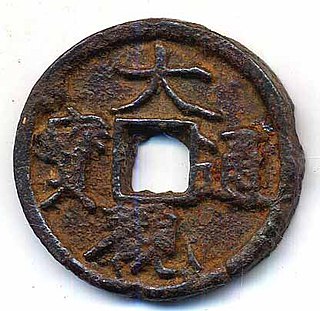 W
WIron cash coins are a type of Chinese cash coin that were produced at various times during the monetary history of imperial China. Iron cash coins were often produced in regions where the supply of copper was insufficient, or as a method of paying for high military expenditures at times of war, as well as for exports at times of trade deficits.
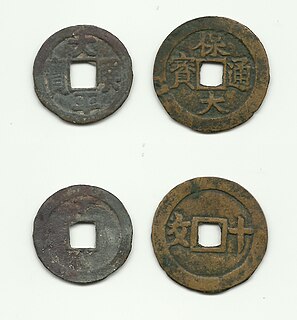 W
WVietnamese cash is a cast round coin with a square hole that was an official currency of Vietnam from the Đinh dynasty in 970 until the Nguyễn dynasty in 1945, and remained in circulation in North Vietnam until 1948. The same type of currency circulated in China, Japan, Korea, and Ryūkyū for centuries. Though the majority of Vietnamese cash coins throughout history were copper coins, lead, iron and zinc coins also circulated alongside them often at fluctuating rates. The reason why coins made from metals of lower intrinsic value were introduced was because of various superstitions involving Vietnamese people burying cash coins, as the problem of people burying cash coins became too much for the government as almost all coins issued by government mints tended to be buried mere months after they had entered circulation, the Vietnamese government began issuing coins made from an alloy of zinc, lead, and tin. As these cash coins tended to be very fragile they would decompose faster if buried which caused the Vietnamese people to stop burying their coins.
 W
WThe mạch was a Vietnamese currency unit introduced in 1837 during the Nguyễn dynasty, the mạch represented a value of 60 văn and was itself 1⁄10 of the quán (貫).
 W
WThe Vietnamese văn as a denomination for Vietnamese cash coins was used from 1868 until 1885 during the reign of the Nguyễn dynasty. The inspiration to introduce the văn may have been to emulate the Chinese wén used on contemporary Qing dynasty cash coins which had just become a fiat currency, however unlike the Chinese system where all Chinese cash coins were cast from the same metals the and the wén was the primary unit of account, the Vietnamese system used the văn as a basic number currency symbol indicating how much zinc cash coins a brass cash coin was worth, while it used the mạch (陌) and quán (貫) as units of account. It was abolished as a measurement for zinc cash coins when the French Indochinese piastre was introduced, after which the term still appeared on Vietnamese cash coins but represented a subdivision of the piastre known in French as sapèque as the production of zinc coinage was ceased by the Imperial government of the Nguyễn dynasty around the year 1871.
 W
WThe Western Xia was a Tangut-led Chinese dynasty which ruled over what are now the northwestern Chinese provinces of Ningxia, Gansu, eastern Qinghai, northern Shaanxi, northeastern Xinjiang, southwest Inner Mongolia, and southernmost Outer Mongolia from 1032 until 1227 when they were destroyed by the Mongols. The country was established by the Tangut people; likewise its earliest coins were escribed with Tangut characters, while later they would be written in Chinese. Opposed to Song dynasty coins that often read top-bottom-right-left, Western Xia coins exclusively read clockwise. Despite the fact that coins had been cast for over a century and a half, very little were actually produced and coins from Western Xia are a rarity today. Although the Western Xia cast their own coins barter remained widely used.
 W
WXin dynasty coinage was a system of Ancient Chinese coinage that replaced the Wu Zhu cash coins of the Han dynasty and was largely based on the different types of currencies of the Zhou dynasty, including Knife money and Spade money. During his brief reign, Wang Mang introduced a total of four major currency reforms which resulted in 37 different kinds of money consisting of different substances, different patterns, and different denominations.
 W
WA yeopjeon was a Korean brass coin with a square cut out which was first issued in 1678 and continued until the final years of the Chosun Dynasty. While coins with a similar design had been unsuccessfully used during the earlier Goryeo period as well.
 W
WThe Yuan dynasty was a Mongol-ruled Chinese dynasty which existed from 1271 to 1368. After the conquest of the Western Xia, Western Liao, and Jin dynasties they allowed for the continuation of locally minted copper currency, as well as allowing for the continued use of previously created and older forms of currency, while they immediately abolished the Jin dynasty’s paper money as it suffered heavily from inflation due to the wars with the Mongols. After the conquest of the Song dynasty was completed the Mongols started issuing their own copper coins largely based on older Jin dynasty models, though eventually the preferred Mongol currency became the Jiaochao and silver sycees, as coins would eventually fall largely into disuse. Although the Mongols at first preferred to have every banknote backed up by gold and silver, high government expenditures forced the Yuan to create fiat money in order to sustain government spending.
 W
WStandard cash, or regulation cash coins, is a term used during the Ming and Qing dynasties of China to refer to standard issue copper-alloy cash coins produced in imperial Chinese mints according to weight and composition standards that were fixed by the imperial government. The term was first used for Hongwu Tongbao cash coins following the abolition of large denomination versions of this cash coin series.